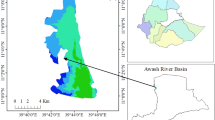Abstract
Regional groundwater modeling is a valuable tool for ensuring the sustainable development and management of groundwater resources as it allows the assessment of the aquifer behavior under different types of hydrological stresses. The objective of this study was to use 3D flow modeling to assess the best options for managing groundwater in the Wadi Baysh basin in Saudi Arabia. The model for the Wadi Baysh aquifer system was based on groundwater monitoring data for 10-year period from 2007 to 2016. The model was tested with different hydrological stresses until the year 2050. The model behavior shows that groundwater levels in Wadi Baysh aquifer show no signs of depletion at the current pumping rates. The impact of the water stored in the dam reservoir is clearly seen and the zone of influence is very well demarcated. At this stage, groundwater use in the Wadi Baysh aquifer system is sustainable and no decline in groundwater levels is observed.


















Similar content being viewed by others
References
Alsharhan AS, Rizk ZA, Nairn AEM, Bakhit DW, Alhajari SA (2001) Hydrogeology of an arid region: the Arabian Gulf and adjoining areas. Elsevier. https://doi.org/10.1016/B978-044450225-4/50012-9
Bredehoeft J (2005) The conceptualization model problem—surprise. Hydrogeol J 13:37–46
Chatterjee R, Ray R (2014) Assessment of Groundwater resources—an overview of international practices. CGWB, Minist Water Resour
Darcy HPG (1856) Les Fontaines publiques de la ville de Dijon. Exposition et application des principes à suivre et des formules à employer dans les questions de distribution d'eau, etc. Victor Dalamont
Harbaugh AW (1990) A computer program for calculating subregional water budgets using results from the US Geological Survey modular three-dimensional finite-difference ground-water flow model
Harley CD, Randall HA, Hultgren KM, Miner BG, Sorte CJ, Thornber CS, Rodriguez LF, Tomanek L, Williams SL (2006) The impacts of climate change in coastal marine systems. Ecol Lett 9:228–241
McDonald MG, Harbaugh AW (1988) A modular three-dimensional finite-difference ground-water flow model, vol 6. US Geological Survey, Reston, p A1
Neumann B, Vafeidis AT, Zimmermann J, Nicholls RJ (2015) Future coastal population growth and exposure to sea-level rise and coastal flooding-a global assessment. PLoS One 10:e0118571
Senthilkumar M, Elango L (2004) Three-dimensional mathematical model to simulate groundwater flow in the lower Palar River basin, southern India. Hydrogeol J 12:197–208
Stefanova A, Krysanova V, Hesse C, Lillebø AI (2015) Climate change impact assessment on water inflow to a coastal lagoon: the Ria de Aveiro watershed, Portugal. Hydrol Sci J 60:929–948
Taylor RG, Scanlon B, Döll P, Rodell M, Van Beek R, Wada Y, Longuevergne L, Leblanc M, Famiglietti JS, Edmunds M, Konikow L (2013) Groundwater and climate change. Nat Clim Change 3:322
Todd D (2005) Groundwater hydrology, 3rd edn. Wiley, New York
Vetrimurugan E, Senthilkumar M, Elango L (2017) Solute transport modeling for assessing the duration of river flow to improve the groundwater quality in an intensively irrigated deltaic region. Int J Environ Sci Technol 14:1055–1070
Acknowledgements
Authors express their gratitude and appreciation to King Abdulaziz City for Science and Technology (KACST) for providing the research grant Project (336-34-أت#). Authors are grateful to Professor Michael Schneider- Frei Berlin University-Germany for his guidance and contribution to this project. Authors express also their special gratitude and thanks to Mr. Syed Faisal Zaidi, Mohammad Albishi and Saud Al Gedaani of Water Research Center- King Abdulaziz University (KAU).
Author information
Authors and Affiliations
Corresponding author
Additional information
Publisher's Note
Springer Nature remains neutral with regard to jurisdictional claims in published maps and institutional affiliations.
Rights and permissions
About this article
Cite this article
Masoud, M.H.Z., Basahi, J.M. & Zaidi, F.K. Groundwater resource management based on three-dimensional flow modeling of Wadi Baysh aquifer system: southwestern Saudi Arabia. Environ Earth Sci 78, 562 (2019). https://doi.org/10.1007/s12665-019-8575-7
Received:
Accepted:
Published:
DOI: https://doi.org/10.1007/s12665-019-8575-7




